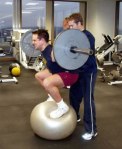This is a rebuttal to a minefield of a post over at mamamia.com.au, from yet another journo seemingly in favour of the promotion of overweight, obesity and associated chronic diseases – all seemingly in disguise as the altruistic promotion of self-acceptance of body image.
I’m going to start this rebuttal by first disclosing a few potential conflicts of interest on my part:
- I work as an Exercise Physiologist with clients with chronic illness, musculoskeletal injuries, and other diseases, so I have a specific interest in overweight/obesity and how it impacts on their health conditions. You might even go so far as to say that my opinion is somewhat informed and that I have some background on the matter.
- I’ve written a post in the past on my blog Skeptifit.com about my views on the “Big is Beautiful” crowd. Admittedly sensational, but keep in mind that that too was a rebuttal to a misinformed journalist, so do excuse some of the loaded language.
In a nutshell, I’m not a supporter, and I believe the journos should stay out of healthcare alltogether and stick to what they know best, reporting the news, not attempting to understand and interpret scientific literature that is well outside their scope of practice.
Discussion Points:
1. “Concern trolling”. The author writes:
“At the bottom of nearly every article celebrating body diversity, you will likely find some version of the following comments:
- “Aren’t you promoting an unhealthy lifestyle?”
- “I’m all about confidence, but this is just unhealthy.”
- “I just don’t find fat people attractive, that doesn’t make me a bad person.”
- “I have no sympathy for these people, they bring it on themselves.”
- “Think of the children!”
This is not concern trolling, it’s genuine concern. The author is either unaware of what trolling is or is straw-manning genuine comments for trolling comments, and we’re left with the impression that she’s attempting to undermine any valid criticism that have been levelled at her or others by poisoning the well and launching personal attacks.
For a definition of what concern trolling actually is I’ll paste a defintion from Urban Dictionary, which I think is sufficient for our purposes (second definintion was clearer):
“In an argument (usually a political debate), a concern troll is someone who is on one side of the discussion, but pretends to be a supporter of the other side with “concerns”. The idea behind this is that your opponents will take your arguments more seriously if they think you’re an ally. Concern trolls who use fake identities are sometimes known as sockpuppets.
(eg) In the 2006 election, an aide to Congressman Charlie Bass (R-NH) was caught concern trolling the opposition on local blogs. While pretending to support Bass’s opponent, Paul Hodes, the aide argued that Hodes couldn’t win because Bass was an unbeatable candidate. Hodes won the election.”
I won’t go into depth examining semantics, technical vs colloquial usage of terms and different dictionary definitions. I think the tone of the opening speaks for itself and immediately calls into question the existance of alterior motives or conflicting interests on her part.
2. “People are allowed to make their own decisions regarding their own bodies, but we need to start treating people of all sizes with respect”
Nonsense. We no more need to respect a persons decision to live an unhealthy lifestyle than we respect their decision to engage in any other behaviour which might harm themselves or others, or that creates a burden on the healthcare system. An important distinction here – we respect their right to *make* that decision, but we don’t have to respect the decision itself, and we certainly don’t have to respect the person.
Many people might think I’m splitting hairs here, and I agree it’s a fine distinction, but again I think it’s an important one as I truly believe that respect is earned through displaying reasonable action and behaviour, and not freely given. In addition, the fact that all overweight/obese people immediately deserve respect for their lifestyle habits regardless what those habits actually are is an absurd generalisation which is almost as ridiculous as claiming that all overweight/obese people are in their condition because they are lazy. Neither extreme is correct, neither the straw-man examples provided by the author nor the authors position on the subject.
3. “BMI is BS”
Somewhat agree, for the reasons stated, but this is hardly a controversial point and most people (at least those who walk into my office) are already aware of this. Also this is only support for the fact that they should be talking to a health professional who takes a variety of anthropometrical and girth measurements to assess health measures within the context of other presenting chronic disease, rather than a simple BMI, and those readings then interpreted in context.
The historical points were an interesting read, however it’s a shame the link was broken and the source of the authors information can’t be verified (the source, not the information iteslf). It also makes one wonder why the sourced website might have pulled the page, if the link was the correct one in the first place.
4. “Fatness”
What exactly does this word mean? The author keeps using it as
though they’re trying to claim it and instill some sense of pride, which I guess is fine, but outside of that it’s a subjective term that adds absolutely no value to the discussion. While the inherent BMI problems with overweight and obesity were already outlined, they’re certainly much more useful classifications than totally subjective terms like “fatness” which appeal more to individual aesthetic preferences than anything else. Further to this, BMI certainly is a very useful tool for everyday, regular people who are not rugby players or pro athletes with an absurdly muscular build, as long as it’s interpreted within the context of other readings and measures.
5. “One’s relationship to food shouldn’t reflect on who they are as a human being”
Again, I call nonsense. Why shouldn’t it? Everything we do reflects on us as human beings, if your relatioship with food is unhealthy or you simply like to eat a lot, well I have news for you…that’s going to reflect on you, just like any other behaviour that you engage in reflects on you. You don’t get a free pass simply because some people (like the author) seem to want to make the issue taboo to discuss.
6. “But that’s not always the case: Multiple studies have seen little to no connection between weight loss and decreased risk of mortality.
Now this is probably the most salient point of the authors post, but again I think she missed the mark and is incredibly short sighted – perhaps due to her lack of expertise in the area of chronic disease.
The first link here is to an article posted on the NIH for people with Type 2 diabetes and obesity (not other demographics), so while it’s certainly informative for that sub-group of people it does not apply to the general population. The second link is a single study which shows that dietary intervention was not associated with improved health outcomes in the absence of exercise and health service interventions. It’s true that the issue of weight loss in overweight and obese people is controversial if they do not also present with other indicators of disease, but it’s also true that many overweight/obese individuals who also have chronic disease can see plenty of benefit from weight loss.
It seems as though the authors entire argument hinges on the Obesity Paradox, something which she’s implicitly generalising to all obese people as though it’s the norm. Just because there are exceptions for a small demographic doesn’t mean we should wholesale shift our position on the health risks of overweight and obesity, and I think the preponderance of evidence is still in favour of decreasing fat mass if a person is in the overweight/obese category, and achieving this objective through both nutritional and exercise-based methodologies.
7. “Not everyone wants to be skinny”
I find it kind of ironic that at this point, not only is the author implying that healthy weight = “skinny” (aka underweight, typically – so here she’s using a false dichotomy fallacy between being overweight or being skinny), and in addition to this slight of hand posts a picture of two women who for all intents and purposes, as far as can be seen from the picture, or at a relatively healthy weight range – which is exactly what health professioanls are advocating that most people should be striving to achieve!
Don’t drink the coolade, stay skeptical.
What are your thoughts?



















